Severodvinsk
Severodvinsk (Russian: Северодвинск, IPA: [sʲɪvʲɪrɐdˈvʲinsk]) is a city in the north of Arkhangelsk Oblast, Russia, located in the delta of the Northern Dvina River, 35 kilometers (22 mi) west of Arkhangelsk, the administrative center of the oblast. As of the 2010 Census, the population was 192,353.[8] Due to the presence of important military shipyards (specialised in submarines since the Soviet period), Severodvinsk is an access restricted town for foreign citizens. A special permit is required.[16]
Severodvinsk Северодвинск | |
|---|---|
City[1] | |
 Lomonosova Street in Severodvinsk | |
 Coat of arms | |
| Anthem: Anthem of Severodvinsk[2] | |
Location of Severodvinsk 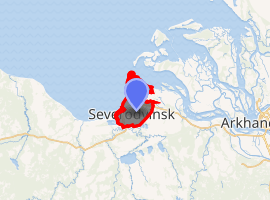
| |
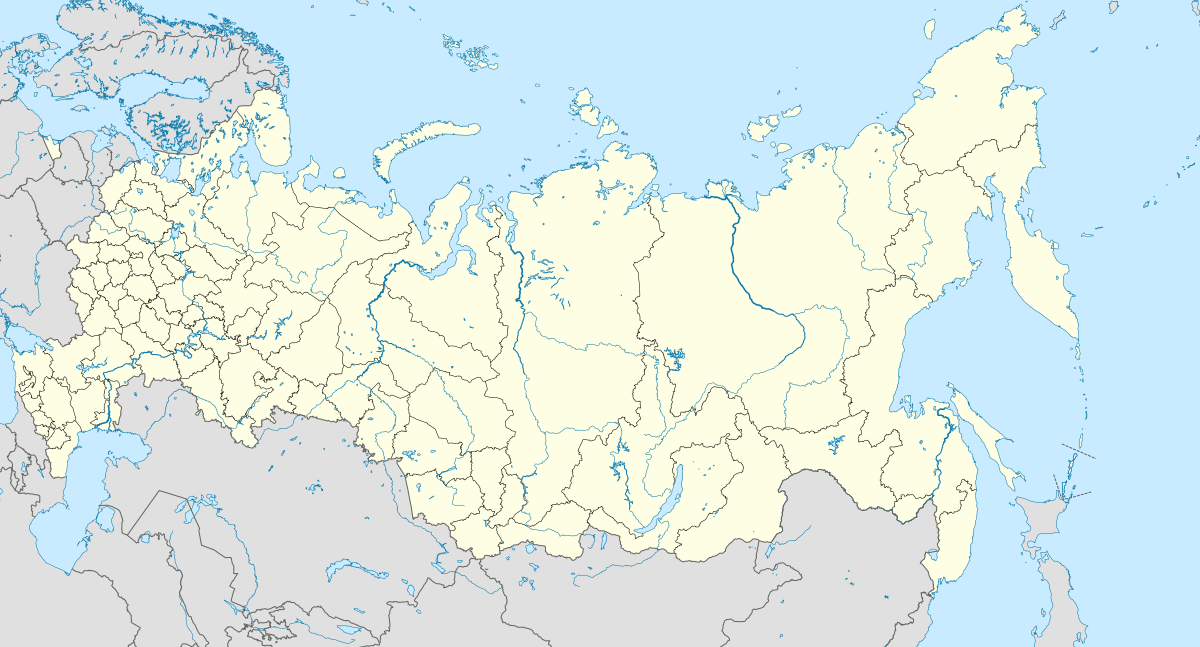 Severodvinsk Location of Severodvinsk  Severodvinsk Severodvinsk (Arkhangelsk Oblast) | |
| Coordinates: 64°34′N 39°52′E | |
| Country | Russia |
| Federal subject | Arkhangelsk Oblast[3] |
| Founded | 1936[4] |
| Government | |
| • Body | City Council of Deputies[5] |
| • Mayor[6] | Igor Skubenko (since 2017)[7] |
| Elevation | 7 m (23 ft) |
| Population | |
| • Total | 192,353 |
| • Estimate (2018)[9] | 183,255 (-4.7%) |
| • Rank | 95th in 2010 |
| • Subordinated to | city of oblast significance of Severodvinsk[10] |
| • Capital of | city of oblast significance of Severodvinsk[10] |
| • Urban okrug | Severodvinsk Urban Okrug[11] |
| • Capital of | Severodvinsk Urban Okrug[11] |
| Time zone | UTC+3 (MSK |
| Postal code(s)[13] | 164500–164502, 164504, 164505, 164507, 164509, 164510, 164512, 164514, 164515, 164518, 164520–164524, 164529 |
| Dialing code(s) | +7 81842[14] |
| OKTMO ID | 11730000001 |
| City Day | Last Sunday of July[15] |
| Website | www |
It was previously known as Sudostroy (until 1938),[4] Molotovsk (until 1957).[4]
History
Pre-20th century
Vikings explored the territories around the North Dvina River - part of Bjarmaland - at the start of the second millennium. British and Norman[4] ships came to these places for mining, fur and fishing before the 13th century, but later the climate became colder and access to the northern seas became closed.
The historical records first mention the settlement on the site of modern Severodvinsk in 1419, when the Swedes sailed into the bay and burnt down the Nikolo-Korelsky Monastery that stood by the shore during the Swedish–Novgorodian Wars. Tradition states that Saint Euphemius, an Orthodox missionary in Karelia, founded this monastery. The abbey stood in ruins until 1471, when two sons of Marfa Boretskaya died in a vicious storm; their bodies were recovered on the beach near the monastery twelve days later. At the urging of Boretskaya, the monastery was restored and her sons were buried there.
On August 24, 1553, a ship of Richard Chancellor reached the salt-mining settlement of Nyonoksa, which is still famous for its traditional wooden architecture. The British sailors visited the Nikolo-Korelsky Monastery, where they were surprised to find a community of "sailors in soutanes (cassocks)" and a pier large enough to accommodate several ships. The main church of this extraordinary establishment was dedicated to Saint Nicholas, the holy patron of sailors; hence, the whole White Sea became known in 16th-century English maps as "St. Nicholas Bay". In late 1613, during the Time of Troubles in Russia, Polish-Lithuanian vagabonds, the Lisowczycy, captured and looted Severodvinsk with the monastery.
The Nikolo-Korelsky Monastery flourished after the establishment of the Muscovy Company, as the bulk of their trade passed through the local harbor. In August 1618 the harbour was visited by John Tradescant the elder, who conducted a survey of an island situated opposite the monastery. This island became known to the British as "Rose Island", because it was there that Tradescant found an exceedingly rare plant which he named "Rosa moscovita" and brought back to London.[17]
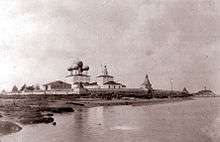
The surviving buildings of the monastery were constructed at the close of the Muscovite period. The five-domed cathedral of St. Nicholas was built between 1670 and 1674, preceded by the Assumption church (1664–1667), to which it is joined by a gallery. Several decades later, the walls and towers were built of timber; the Soviets transported the best-preserved of these towers to Kolomenskoye, Moscow, where it still remains.
Modern city
Severodvinsk is the second-largest city in Arkhangelsk Oblast. Its main industry remains defense-related — the construction and repair of submarines at the huge Northern Machine-building Enterprise SEVMASH (Северное Машиностроительное Предприятие-СЕВМАШ). The Soviet Union's first nuclear submarine Leninsky Komsomol was built here in 1957. At the beginning of the 1980s the world's largest submarine, a Typhoon class, was also built here, later recorded in the Guinness Book of World Records.
The modern city of Severodvinsk developed in the Soviet period. As it began to be built it was called Sudostroy (Судострой - "Boat-build").[4] It received town status in 1938 and until 1957 was named Molotovsk (Молотовск), after Vyacheslav Molotov.[4] On September 12, 1957 it was renamed Severodvinsk (meaning "Northern Dvina town").
During World War II a significant portion of the materials delivered by the Arctic Convoys to Murmansk and Arkhangelsk for the Soviet Union were unloaded in Severodvinsk. For example, the Empire Elgar, a British heavy lift ship that arrived in Arkhangelsk with convoy PQ 16 and subsequently spent eight weeks unloading ships from the ill-fated convoy PQ 17.
A Russian naval-base supports the sea trials of nuclear submarines from the major submarine construction- (64.5817 N, 39.8307 E) and repair-facilities located in the area. In Soviet times the 17th-century buildings of the Nikolo-Korelsky monastery, located on the territory of the shipyard, were adapted and used for shipbuilding purposes.[18] In recent years the monastery buildings, specifically the main church, have been restored and re-consecrated. Church-goers attending services have to be shipyard workers or able to obtain a pass to enter the church portion of the shipyard.
Severodvinsk is an access-restricted town for foreign citizens. A special pass is required.[16]
On 8 August 2019 a nuclear accident took place on Russian Navy’s Central Missile Range in Nyonoksa, 30 km to the west from Severodvinsk.[19]
Administrative and municipal status
Within the framework of administrative divisions, it is, together with eleven rural localities, incorporated as the city of oblast significance of Severodvinsk—an administrative unit with the status equal to that of the districts.[10] As a municipal division, the city of oblast significance of Severodvinsk is incorporated as Severodvinsk Urban Okrug.[11]
Demographics
Population: 192,353 (2010 Census);[8] 201,551 (2002 Census);[20] 248,670 (1989 Census).[21]
From 1950 until 1990, high-tech industries generated demand for a considerable quantity of suitably qualified experts and workers which prompted growth in population. Since 1992, the population has declined due to economic crises and unemployment that has provoked significant migration from the city.
Economy
Industry
The main role of the city has been, and remains, the production and repair of submarines and military ships. During the Cold War, the city prospered, but with the decline and break-up of the Soviet Union and the end of the Cold War the city has declined. The city's large military enterprises have survived the economic crises of the 1990s and have adjusted to new economic conditions. Severodvinsk now has the largest shipbuilding yard in Russia for large ships (tankers, cargo ships).
Large and military factories
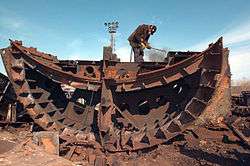
- "SevMash"(СевМаш) or Northern Machine-building Enterprise (Северное машиностроительное предприятие)
- core line of business is the construction and repair of submarines and other naval ships, as well as civilian vessels and oil platforms
- "Zvezdochka" (Звёздочка ("Starlet"))
- Repair of submarines, military and civil ships, construction of oil platforms and faceting of diamonds.
- "Severny Reyd" (Северный рейд("Northern Raid"))
- Manufacture of marine equipment.
- "Arktika" (Арктика ("Arctic"))
- Manufacture of automated equipment.
Transportation
Severodvinsk is the terminal station of a railway line which splits of at Isakogorka station from the line connecting Moscow and Arkhangelsk.
The Kudemskaya narrow-gauge railway in 2010 has appeared in Forbes ranking, of 10 most beautiful railway routes of the world.

Sport
Sport teams representing Severodvinsk in city, regional and all-Russian competitions:
Social sphere
Education
There are 32 middle schools of general education in Severodvinsk, including special schools for orphans and handicapped children; two musical schools and two art schools.
Secondary vocational education institutions
- Technical College (part of the Northern (Arctic) Federal University since 2011)
- Technical School of Construction, Design and Technology
- Technical School of Shipbuilding and Engineering
- Technical School of Shipbuilding and Ship Repair
- Technical School of Social Infrastructure
- Technical School of Wiring and Communication
- College of Management and Information Technology
- Branch of Arkhangelsk Medical College
Higher education institutions
The city hosts branches of the following institutions:
- Northern (Arctic) Federal University (including Institute of Shipbuilding and Maritime Arctic Engineering (ISMART) and Institute of Humanities)
- International Institute of Management (Arkhangelsk)
- Moscow Modern Humanitarian Academy
- Northwest Academy of the State Service (St. Petersburg)
Monuments
There are nearly twenty monuments and memorial complexes in the city, including:
- a monument honoring the city founders on Pashaeva Square (a 30-meter sculpture);
- a monument to the renowned Russian scientist Mikhail Lomonosov, who was born in the region. One of the city's central streets is named after him;
- two monuments to Vladimir Lenin;
- the city gate, on the road from Arkhangelsk;
- a monument to the home front workers of World War II;
- military memorial complex on Yagry island which includes monument to World War II participants "The Grieving Motherland", monuments to the victims of the Kursk submarine disaster and the liquidators of the Chernobyl disaster.
Cultural heritage
Fifteen objects in Severodvinsk are protected as cultural heritage monuments[22] In particular, the Nyonokotsky Pogost in the village of Nyonoksa is protected as an architecture monument on the federal level. This is one of the few surviving triple wooden church ensembles, consisting of two churches (a bigger, not heated, church used in the summer, a smaller, heated church used in the winter) and a bell-tower. Nyonoksa was also notable for salt production.
In addition, the wooden Church Resurrection of Christ, currently located on Yagry Island in the northern part of Severodvinsk, was relocated there in 1990s and was the first religious building open in the city. The church was built in the end of 19th century in the village of Solza about 20 kilometers (12 mi) from Severodvinsk.
The stone church of St. Nicholas is located in the eastern portion of the SEVMASH Shipyard. The church building is the last remnant of the Svyato-Nikolskoye Monastery which served as the gateway to the pilgrimage monastery on the Solovetskiy Islands from the 15th century.
City in culture
- K-19: The Widowmaker
- Nuclear underwater epic, film of Discovery Channel
- Documentary film of Alexandr Ipatov, "Severodvinsk, a bird's-eye view" (Russian "Северодвинск, вид с высоты птичьего полёта")
- Seven Days, Season 1, Episode 13, "Last Breath"
Notable people
- Polina Agafonova, Russian figure skater, was born in Severodvinsk in 1996.
- Svetlana Klyukina, Russian artistic gymnast and a member of Russian Olympic team on 2008 Summer Olympics, was born in Severodvinsk in 1989.
- Marina Prusakova, widow of Lee Harvey Oswald, the assassin of US President John F. Kennedy in 1963, was born in Molotovsk in 1941.[23]
- Olga Rukavishnikova, Soviet athlete who mainly competed in the women's pentathlon event during her career, was born in Molotovsk in 1955.
- Mikhail Suprun, Russian historian and professor of the Pomor State University named after M. V. Lomonosov, was born in Molotovsk in 1955.
Twin towns and sister cities
Severodvinsk is twinned with:
Climate
Serevodvinsk has a subarctic climate (Köppen climate classification Dfc).
| Climate data for Severodvinsk | |||||||||||||
|---|---|---|---|---|---|---|---|---|---|---|---|---|---|
| Month | Jan | Feb | Mar | Apr | May | Jun | Jul | Aug | Sep | Oct | Nov | Dec | Year |
| Average high °C (°F) | −9.6 (14.7) |
−8.3 (17.1) |
−2.9 (26.8) |
4.1 (39.4) |
10.8 (51.4) |
17.6 (63.7) |
20.9 (69.6) |
18.3 (64.9) |
11.5 (52.7) |
3.9 (39.0) |
−2.2 (28.0) |
−6.6 (20.1) |
4.8 (40.6) |
| Daily mean °C (°F) | −14.5 (5.9) |
−12.2 (10.0) |
−6.3 (20.7) |
−0.2 (31.6) |
6.5 (43.7) |
12.6 (54.7) |
15.8 (60.4) |
13.2 (55.8) |
7.8 (46.0) |
1.6 (34.9) |
−4.5 (23.9) |
−10.3 (13.5) |
0.8 (33.4) |
| Average low °C (°F) | −16.6 (2.1) |
−15.6 (3.9) |
−11.7 (10.9) |
−4.6 (23.7) |
1.9 (35.4) |
7.9 (46.2) |
11.2 (52.2) |
9.8 (49.6) |
5.2 (41.4) |
−0.6 (30.9) |
−7.2 (19.0) |
−13.2 (8.2) |
−2.7 (27.1) |
| Average precipitation days | 21 | 19 | 19 | 16 | 15 | 15 | 13 | 16 | 16 | 21 | 22 | 24 | 217 |
| Source: pogoda.ru[24] | |||||||||||||
References
Notes
- Государственный комитет Российской Федерации по статистике. Комитет Российской Федерации по стандартизации, метрологии и сертификации. №ОК 019-95 1 января 1997 г. «Общероссийский классификатор объектов административно-территориального деления. Код 11 430 005», в ред. изменения №278/2015 от 1 января 2016 г.. (State Statistics Committee of the Russian Federation. Committee of the Russian Federation on Standardization, Metrology, and Certification. #OK 019-95 January 1, 1997 Russian Classification of Objects of Administrative Division (OKATO). Code 11 430 005, as amended by the Amendment #278/2015 of January 1, 2016. ).
- Decision #123
- Law #65-5-OZ, Article 15.1.1
- Severodvinsk—test of strength (Russian), "Pravda Severa" publishing house, 1998
- Charter of Severodvinsk, Article 33.1.1
- Charter of Severodvinsk, Article 33.1.2
- Official website of the Administration of Severodvinsk. Mikhail Arkadyevich Gmyrin, Mayor of Severodvinsk (in Russian)
- Russian Federal State Statistics Service (2011). "Всероссийская перепись населения 2010 года. Том 1" [2010 All-Russian Population Census, vol. 1]. Всероссийская перепись населения 2010 года [2010 All-Russia Population Census] (in Russian). Federal State Statistics Service.
- "26. Численность постоянного населения Российской Федерации по муниципальным образованиям на 1 января 2018 года". Federal State Statistics Service. Retrieved January 23, 2019.
- Oblast Law #65-5-OZ
- Oblast Law #258-vneoch.-OZ
- "Об исчислении времени". Официальный интернет-портал правовой информации (in Russian). June 3, 2011. Retrieved January 19, 2019.
- Почта России. Информационно-вычислительный центр ОАСУ РПО. (Russian Post). Поиск объектов почтовой связи (Postal Objects Search) (in Russian)
- Телефонный код города Северодвинск (in Russian). Коды городов. Retrieved August 26, 2011.
- Charter of Severodvinsk, Article 1.3
- http://www.pomorland.travel/en/kak_dobratsya/kuda_ne_dobratsya/
- Hamel, Joseph. England and Russia: Comprising the Voyages of John Tradescant, the Elder... Adamant Media Corporation. p. 282. ISBN 1-4021-8427-1.
- "XX век" (in Russian). Управление образования Северодвинска. Retrieved August 26, 2011.
- meduza.io https://meduza.io/amp/en/feature/2019/08/27/new-russian-government-data-on-august-8-explosion-reveals-that-a-nuclear-reactor-was-definitely-involved. Retrieved August 31, 2019. Missing or empty
|title=(help) - Russian Federal State Statistics Service (May 21, 2004). "Численность населения России, субъектов Российской Федерации в составе федеральных округов, районов, городских поселений, сельских населённых пунктов – районных центров и сельских населённых пунктов с населением 3 тысячи и более человек" [Population of Russia, Its Federal Districts, Federal Subjects, Districts, Urban Localities, Rural Localities—Administrative Centers, and Rural Localities with Population of Over 3,000] (XLS). Всероссийская перепись населения 2002 года [All-Russia Population Census of 2002] (in Russian).
- "Всесоюзная перепись населения 1989 г. Численность наличного населения союзных и автономных республик, автономных областей и округов, краёв, областей, районов, городских поселений и сёл-райцентров" [All Union Population Census of 1989: Present Population of Union and Autonomous Republics, Autonomous Oblasts and Okrugs, Krais, Oblasts, Districts, Urban Settlements, and Villages Serving as District Administrative Centers]. Всесоюзная перепись населения 1989 года [All-Union Population Census of 1989] (in Russian). Институт демографии Национального исследовательского университета: Высшая школа экономики [Institute of Demography at the National Research University: Higher School of Economics]. 1989 – via Demoscope Weekly.
- Памятники истории и культуры народов Российской Федерации (in Russian). Russian Ministry of Culture. Retrieved June 2, 2016.
- Голубцова, Ольга Валентиновна (1993). Русская жена убийцы президента: Молотовск-Даллас (in Russian). Северодвинск.
- "Historical Weather for Severodvinsk". Retrieved August 25, 2011.
Sources
- Местный референдум. 16 июня 1996 г. «Устав муниципального образования "Северодвинск"», в ред. Решения №27 от 25 марта 2010 г «О внесении изменений и дополнений в Устав Северодвинска». Опубликован: "Северный рабочий", №196, 15 октября 1996 г. (Local referendum. June 16, 1996 Charter of the Municipal Formation of "Severodvinsk", as amended by the Decision #27 of March 25, 2010 On Amending and Supplementing the Charter of Severodvinsk. ).
- Архангельское областное Собрание депутатов. Областной закон №65-5-ОЗ от 23 сентября 2009 г. «Об административно-территориальном устройстве Архангельской области», в ред. Областного закона №232-13-ОЗ от 16 декабря 2014 г. «О внесении изменений в отдельные Областные Законы в сфере осуществления местного самоуправления и взаимодействия с некоммерческими организациями». Вступил в силу через десять дней со дня официального опубликования. Опубликован: "Волна", №43, 6 октября 2009 г. (Arkhangelsk Oblast Council of Deputies. Oblast Law #65-5-OZ of September 23, 2009 On the Administrative-Territorial Structure of Arkhangelsk Oblast, as amended by the Oblast Law #232-13-OZ of December 16, 2014 On Amending Various Oblast Laws Dealing with the Process of Municipal Self-Government and Relations with Non-Profit Organizations. Effective as of the day which is ten days after the official publication.).
- Архангельское областное Собрание депутатов. Областной закон №258-внеоч.-ОЗ от 23 сентября 2004 г. «О статусе и границах территорий муниципальных образований в Архангельской области», в ред. Областного закона №224-13-ОЗ от 16 декабря 2014 г. «Об упразднении отдельных населённых пунктов Соловецкого района Архангельской области и о внесении изменения в статью 46 Областного закона "О статусе и границах территорий муниципальных образований в Архангельской области"». Вступил в силу со дня официального опубликования. Опубликован: "Волна", №38, 8 октября 2004 г. (Arkhangelsk Oblast Council of Deputies. Oblast Law #258-vneoch.-OZ of September 23, 2004 On the Status and Borders of the Territories of the Municipal Formations in Arkhangelsk Oblast, as amended by the Oblast Law #224-13-OZ of December 16, 2014 On Abolishing Several Inhabited Localities in Solovetsky District of Arkhangelsk Oblast and on Amending Article 46 of the Oblast Law "On the Status and Borders of the Territories of the Municipal Formations in Arkhangelsk Oblast". Effective as of the day of the official publication.).
- Муниципальный Совет Северодвинска. Решение №123 от 28 октября 2004 г. «Об утверждении Положения "О гимне города Северодвинска"». Вступил в силу с момента опубликования. Опубликован: "Северный рабочий" ("Вестник муниципального Совета Северодвинска"), №198–200, 14 декабря 2004 г. (Municipal Council of Severodvinsk. Decision #123 of October 28, 2004 On the Adoption of the Provision "On the Anthem of the City of Severodvinsk". Effective as of the moment of publication.).
External links
- (in Russian) Official website of Severodvinsk
- (in Russian) Unofficial website of Severodvinsk
- (in Russian) History of the Nikolo-Korelsky Monastery
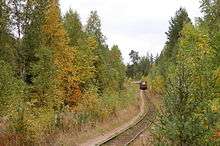
.png)